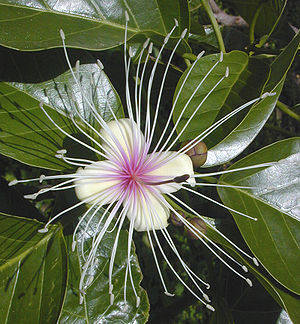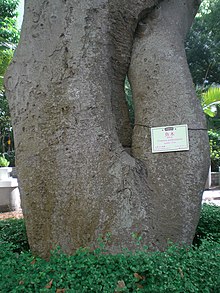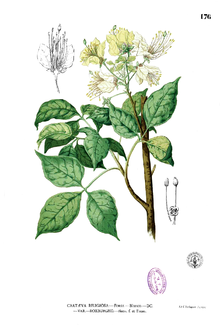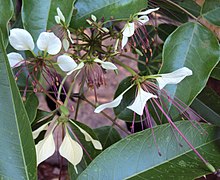Crateva
| Crateva | ||||||||||||
|---|---|---|---|---|---|---|---|---|---|---|---|---|

|
||||||||||||
| Systematics | ||||||||||||
|
||||||||||||
| Scientific name | ||||||||||||
| Crateva | ||||||||||||
| L. |
Crateva is a plant genus in the family of capparaceae (Capparaceae). The fruits of some species are eaten or used as ornamental plants.
description


Vegetative characteristics
Crateva species grow as trees or sometimes bushes . They can be evergreen or deciduous. The parts of the plant have no hairs ( trichomes ). The branches are pencil-like or angular with lenticels .
The alternate leaves are arranged in a petiole and a leaf blade. The long petioles have glands near the rachis . The imparipinnate leaf blades are composed of three leaflets. The leaflets initially have a thin stalk that becomes thicker. The terminal leaflet has an asymmetrical base. The stipules are small and triangular.
From the rolled cotyledons ( cotyledons ) one is longer and orbiting the other.
Generative characteristics
At the ends of new branches there are umbrella-clustered , racemose inflorescences , with terminated growth or after flowering the rachis continues to grow into a leafy branch. After the flowers have fallen off, clear scars remain on the rachis. The flowers each stand on long flower stalks over a bract.
The mostly hermaphrodite or unisexual flowers are more or less radial symmetry and four-fold with a double flower envelope (perianth). There are four identical, greenish sepals that are significantly smaller than the petals. The four white, cream-colored to yellow petals are the same, keeled, ovate to rhomboid with four side nerves on each side of the main nerve. Often there are rarely eight to, mostly twelve to fifty stamens with long stamens that are fused together at the base 1 to 4 millimeters long. A gynophore 2 to 8 centimeters long is formed. Fused stamens and gynophore together form an androgynophore . There are two to twelve carpels each. The unicameral ovary is above. There are many ovules . There is a nectarium. There is at most a short stylus. The inconspicuous scars are button-shaped.
It forms spherical to ellipsoidal berries that hang down on stems and contain 25 to 50 seeds. The leathery pericarp dries gray, red, purple or brown and is smooth or papilous on top . The seeds are embedded in a creamy or pungent smelling mesocarp . The seed coats are smooth. The seeds contain a straight embryo.
Systematics and distribution
The eight or so species thrive almost worldwide in the tropics and subtropics . In addition, its area extends north to southern Japan in Asia and south in the Neotropic to northern Argentina. There are five types in China.
The genus name Crateva was first published in 1753 by Carl von Linné in Species Plantarum , 1, p. 444. Type species is Crateva tapia L. Synonyms for Crateva L. are: Belou Adans. , Crataeva L. , Nevosmila Raf. , Othrys Noronha ex Du Petit-Thouars , Tapia Mill. , Triclanthera Raf.

There are about eight types of Crateva :
- Crateva adansonii DC. : It thrives in tropical Africa, in Egypt, in Madagascar. India, Pakistan, Sri Lanka and Myanmar.
- Crateva formosensis (Jacobs) BSSun : It occurs in the Chinese provinces of northern Guangdong , northeastern Guangxi , Taiwan and the Japanese Ryūkyū Islands .
- Crateva magna (Lour.) DC. (Syn: Capparis magna Lour. , Crateva nurvala Buch.-Ham. ): It occurs in India, Bangladesh, Sri Lanka, Malaysia, Indonesia, Thailand, Laos, Cambodia, Myanmar and China.
- Crateva religiosa G.Forst. : It is in Sri Lanka , India , Nepal , Bhutan , Myanmar , Thailand , Cambodia , Vietnam , Guangdong, Hainan , Taiwan, Indonesia , the Philippines, New Guinea, the Solomon Islands, Japan, Queensland, Micronesia and the Society Islands spread.
- Crateva speciosa Volkens : It is native to Micronesia, Palau , Kiribati and the Northern Mariana Islands .
- Crateva tapia L .: It is distributed from Mexico and the Caribbean to Argentina, it is most common in the Atlantic coastal rainforest. In Brazil it is called Trapia.
- Crateva trifoliata (Roxburgh) BSSun : It is common in Cambodia, India, Laos, Myanmar, Thailand, Vietnam, southern Taiwan and the Chinese provinces of Guangdong, Guangxi, Hainan, Yunnan .
- Crateva unilocularis Buchanan-Hamilton : It is common in Bangladesh , India, Bhutan, Nepal, Cambodia, Laos , Myanmar, Vietnam and the Chinese provinces of Fujian , Guangdong, Guangxi, Hainan and Yunnan .
use
In India, Crateva magna eats the young fruits and uses leaves and root bark in folk medicine. For example, due to the fragrant flowers, Crateva religiosa is used as an ornamental plant in China and other countries in southern and southeastern Asia. The dried fruits are used in Chinese medicine. Crateva tapia fruits are eaten by humans and are eaten by animals, including fish.
swell
- Mingli Zhang, Gordon C. Tucker: Capparaceae. : Crateva , p. 433 - the same text online as the printed work , In: Wu Zheng-yi, Peter H. Raven, Deyuan Hong (Ed.): Flora of China. Volume 7: Menispermaceae through Capparaceae. Science Press and Missouri Botanical Garden Press, Beijing and St. Louis 2008, ISBN 978-1-930723-81-8 . (Sections description, distribution, use and systematics)
Individual evidence
- ↑ Carl von Linné: Species Plantarum , 1, 1753, p. 444 scanned in at biodiversitylibrary.org.
- ↑ a b c d e f Crateva in the Germplasm Resources Information Network (GRIN), USDA , ARS , National Genetic Resources Program. National Germplasm Resources Laboratory, Beltsville, Maryland. Retrieved October 7, 2018.

